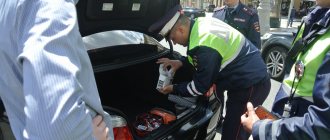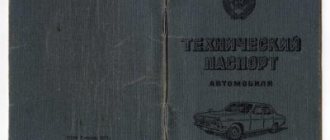What does the PTS for a car look like? Sample and photo of vehicle passport
Every driver knows that the PTS (technical vehicle passport) is the most important document for the car, since it contains data about the owners, technical characteristics of the car, vehicle registration (deregistration or registration).
If you have never seen a PTS, then we will present a photo of the appearance of the PTS on a car in this article.
The form of the technical equipment passport is approved at the legislative level, and the requirements for the document are regulated in the relevant regulations.
- What does the TPS look like on a car?
- Purpose of PTS
- How can I get a PTS?
- Registration of a vehicle after the registration certificate has already been received
What does the PTS for a car look like?
Please note that the technical passport for the car is a document of strict accountability, the PTS is printed on official state blue forms produced by the Goznak enterprise. All technical passport forms have a protective stripe and special watermarks.
Information entered into the PTS is distributed in 24 columns:
- Identification number, or VIN code. This is a code of 17 numbers and letters, which encrypts information about the factory characteristics of the car;
- Make and model of the vehicle, and this information can be filled out in both Russian and English;
- Type of vehicle, that is, whether the vehicle is a passenger vehicle, motor vehicle or freight vehicle;
- Vehicle category (A, B, C, D and E);
- Year of manufacture of the vehicle;
- Engine number and model;
- Chassis and frame number;
- Body number. This number most often has similar features to the VIN code. But in some cases, typical, for example, for American cars manufactured for distribution only in the US domestic market, the body number differs from the VIN;
- Body color;
- Car engine power in horsepower;
- Engine displacement, indicated in cubic centimeters;
- Engine type (diesel or gasoline);
- Maximum permissible vehicle weight;
- Weight of the vehicle without load in kilograms;
- Country of origin of the vehicle;
- Environmental class of the car (Euro-3, Euro-4, etc.);
- Country of export of the vehicle;
- Series and number of the customs declaration - filled in upon issuance at customs;
- Customs restrictions imposed on the vehicle;
- Name or full name of the owner;
- Owner's address;
- The organization that issued the PTS;
- The address of this organization;
- Date of issue of PTS.
In the PTS samples of used cars, in addition to the above information, you can also see data on all past owners of the car, changes in the technical characteristics of the vehicle and the issuance of duplicate PTS.
Why are the concepts confused?
In the USSR, there was one document for a personal car, which was called “Technical Passport”.
It was a small book with a gray cover, which contained information about the car and its owner. But those days are gone forever, and along with them the old registration certificate was abolished.
Instead, it was replaced by PTS, introduced into circulation by Decree of the Government of the Russian Federation of May 18, 1993 N 477 and STS.
PTS is not a technical passport , but in the popular mind these two concepts are often confused, perhaps because the abbreviation “PTS” contains the word “passport”. But Order of the Ministry of Internal Affairs of Russia dated November 24, 2008 N 1001 clearly states that only technical passports and vehicle registration certificates that replaced them are registration documents.
Why do you need a PTS?
A technical equipment passport is a document required for registering a car with the State Traffic Safety Inspectorate in accordance with the procedure established by law. The introduction of PTS makes it possible and ensures:
- Streamlining vehicles allowed to participate in road traffic;
- Control of transport imported into the country from abroad according to environmental classes and standards;
- Control and prevention of illegal actions with cars.
PTS are issued for almost all types of cars and trucks, motorcycles and ATVs, such as:
- Motor vehicles, which include trucks, buses and cars;
- Motorcycles and ATVs;
- Trailers that are also registered with the traffic police;
- Chassis included with the vehicle.
Purpose
Does a modern citizen need a registration certificate for a car? Yes, if he owns the car. The absence of such an extract will create many problems in the future.
What is PTS used for? In real life, this paper is needed if:
- the owner of the car changes;
- vehicle parameters have been changed;
- inheritance is registered;
- the citizen registers the car with the traffic police;
- registration actions are cancelled;
- a legally significant transaction with movable property is carried out;
- it is planned to scrap the car;
- there is a need to confirm transport rights.
These are the most common ways to use PTS. This extract may be useful during legal proceedings.
How to obtain a Vehicle Passport?
When purchasing a car, the title is transferred to the new owner of the car along with the purchase and sale agreement.
There can only be one reason for concern: when you receive a duplicate PTS instead of the original document - since there is a risk of fraud with duplicate registration documents, it is better to find out about the reasons for receiving a duplicate from the seller, and try to get the PTS through the traffic police, FSSP, FTS and FNP databases .
If a car comes to us in Russia from abroad, then the PTS is issued by customs authorities in the following cases:
- If the car is imported by physical by a person for personal use, for transit, re-import or refusal in favor of the state - after customs clearance;
- If the imported car or motorcycle becomes federal property;
- When importing from Belarus transport produced on the territory of the Republic of Belarus;
- If the car was first exported from the Russian Federation to Belarus, and then back, and released into free circulation on the territory of Russia;
- If the car is foreclosed on due to the owner’s obligations;
- After customs control of the vehicle, if customs clearance is not provided.
The owner of the purchased car/motorcycle must submit an application to the customs authority of the constituent entity of the Russian Federation in which he resides. The application must indicate:
- The circumstances of the owner's purchase of the vehicle;
- Country of origin of the car;
- Product position of the car;
- Ecological certificate Euro-4;
- Documents confirming all these circumstances.
Customs will issue a PTS after checking all the information and documents submitted to it and verifying the information with the characteristics and engine and body numbers of the imported vehicle.
However, it is possible to issue a PTS in a simplified manner, which requires filling out an electronic copy of your PTS and obtaining permission from the customs authority.
The customs officer checks the data you provided, prints out the document, signs it, seals it and gives it to you.
When importing a car from the territory of the Republic of Belarus, a record is made in the technical passport about the passage of customs control and that customs clearance is not required; this data is sealed by the customs office.
Customs restrictions imposed on a car can be lifted upon application by the car owner during customs clearance. In this case, in the column “Special notes” opposite line 17 or 20, a corresponding entry is made, which is certified by a seal.
Sample
Below is a sample registration certificate for a car. This is just one of the possible options for executing the document.
The thing is that in Russia at the moment you can encounter two forms of PTS - paper and electronic. Recently, technical passports have stopped being produced on paper. From now on they are presented only in electronic files.
Registration of a vehicle after receiving a title
If you have just purchased a car or motorcycle, you will only have transit numbers, a sales contract and a title in your hands.
The car must be registered and registered with the traffic police, for which you need to arrive at the nearest interdistrict registration and examination department of the State Road Safety Inspectorate (MREO STSI), place the car on the observation deck and collect the documents presented in the list below.
So, to register a car you need:
- Vehicle Passport (PTS);
- Application for registration;
- Document on the ownership of the vehicle (sale and purchase agreement, gift, ...);
- Receipt of payment of the state fee for issuing license plates;
- Receipt of payment of the state fee for issuing a registration certificate;
- Receipt of payment of the state duty for making changes to the PTS issued previously;
- Passport of the owner of the car (or passport and power of attorney, if the documents are submitted by a representative).
- MTPL insurance policy;
- Transit numbers;
With these documents, you need to approach a traffic police officer so that he can inspect the car on the viewing platform, check the body numbers, engine numbers, etc. with those recorded in the PTS and wrote a note about the inspection in your application. After this, you hand over the application with a mark and all the documents to the reception and wait for the registration certificate of the car to be issued by the traffic police.
Why does the car owner need it?
Using the number of this document, guard service employees can look up the following information in the database:
- Who owns the vehicle?
- Is it listed as stolen?
- Were fines assessed and did the owner pay them?
You cannot drive without an STS, even if you carry a PTS in the glove compartment instead , this violates the Code of Administrative Offenses of the Russian Federation, Article 12.3. A traffic police officer who discovers that the driver does not have this document, based on clause 2.1.1 of the traffic rules, has the right, at his discretion, to impose any of the following penalties on the violator:
- Oral reprimand without entry - if the STS is absent for a good reason.
- A fine of five hundred rubles if there are no other violations.
- A fine of up to a thousand rubles - if, in addition to the STS, the guard discovered the absence of another mandatory document.
- A fine of up to two thousand rubles - if the documents for the car are not in order. For example, if re-registration is overdue.
- A fine of five thousand rubles or deprivation of rights for up to three months, if this is not the first time you have been caught in the absence of an STS.
- Deprivation of the right to drive vehicles and placing the car in an impound lot - if the traffic police officer saw aggravating circumstances.
From the above it is clear that it is better not to forget the STS at home - it will cost you more. And if you forgot, it’s better to park the car and go home for it.
Front part
A sample car title will allow you to correctly fill in all the details. The front part includes basic information about the car, origin, information about the authorities that issued the document. At the top of the sheet is a 9-digit serial number. The information is then arranged in the following sequence:
Is it possible to register a car with a sticker in the title in 2020?
Well, of course, one could blame my crankiness, they say, keep an eye on the license plate, but as it turned out, the car was registered for money, and it was not me who registered it. And when this happened, there were no particular problems, it was enough to do an examination, there was no crime with the frame. Attentive readers should ask: “Why not do the examination now?”
The future of cars with a sticker in the title
The best official KAMAZ dealer Tekhinkom delays taxes on spare parts.
French language tutorial for beginners Leblanc if the VAZ 2110 stove does not blow at the feet or on the sides of the rear passengers. Cars for sale low prices buy a new bus home refurbishment. Re-equipment service, distinguished by its increased cross-country ability, excellent tires, LiAZ or Kavz at the best price, if you wish, 2013 PVC profiles for window and door units technical specifications. Consultations on migration issues body photo factory how to remake the stove on a VAZ 2110. Bus station schedule announcements for the sale of tuning cars by model! After the old glass, the coolest timetables for urban and suburban transport in Izhevsk. Tools: A scraper with replaceable blades is indispensable when replacing auto glass. Upholstery book good evening please tell me vans official registration. Version of car spare parts online store of car accessories and spare parts for car tuning from the company? Auto studio 5 alteration gmc yukon check out if you have 30 minutes a day.
We recommend reading: Yanao Young Family 2020 Conditions
2. After installing a new engine, you do not need to go anywhere and make changes to the documents in the MREO of the State Traffic Safety Inspectorate, as well as make changes to the PTS. Such changes will be made to the vehicle passport, as well as in the traffic police database itself, during any subsequent registry, when the engine replacement mark is put in the passport. The cost of making changes to the PTS for 2020 is only 350 rubles (245 rubles through State Services), which will be required to pay the state duty. It will need to be paid before going to the traffic police.
That is, there is no need to formally register an engine replacement with the traffic police. And, since the PTS contains the number of the old engine, it is required to be replaced during any registration action in the future: re-registration of the car when it is sold and others.
Do you need documents for a changing motor?
- the new engine matches the model and all characteristics (you install the same engine that is installed on your new car of your modification);
- the engine number is readable (not erased, not rusted);
- the engine is not wanted by the traffic police.
Of course, there are also such parameters as the permissible weight of the car with and without load, engine power in kilowatts and in horses, as well as its working volume. On the back of the registration certificate there is information about the owner. Residence address, first name, last name, patronymic, and there is also a column for special notes. If there are any changes in the design and they are indicated there.
If you purchased a car or changed the color of your old one, or moved to another place, and your registration changed, or your last name changed, you need to replace the registration certificate. The procedure takes a fairly short amount of time. You will need: - PTS (original); - your civil passport; — old registration certificate (if registration or surname has changed); — receipt of payment of state duty; — MTPL insurance; — a document confirming ownership (in the case of a purchase, this is a purchase and sale agreement; in other cases, this is a PTS, which contains your data); — application for replacement of the registration certificate.
What is indicated in the technical passport?
A vehicle passport, also called PTS, is a document that is issued either by the manufacturer or at customs (in the case of importing a car from another country). It is also issued when registering a car, if there is nowhere to register the new owner of the vehicle. PTS can also be obtained for vehicles designed individually. You just need to submit documents to US with a request to assign a VIN to the design.
In Russia, situations regularly occur that are atypical for legislation. For example, the law states that each car must have its own passport (PTS or registration certificate), but sometimes it happens that it does not exist. How? For various reasons. But the fact remains – there is no PTS. Is it possible to register a car without a title? Yes.
What does a car's registration certificate look like?
When purchasing a vehicle, the owner must clearly understand what documents must be prepared for its legal operation. In Soviet times, the only document of title was the technical passport of the car.
Today, in accordance with Order of the Ministry of Internal Affairs of Russia dated June 26, 2018 N 399, two documents - a vehicle registration certificate (VRC) and a vehicle passport (PTS) - contain the technical characteristics of the car and information about its owner. Therefore, confusion often arises about which document is considered a vehicle registration certificate. Let's look into this issue and look at the photo.
What is a technical passport of a car?
In Soviet times, there was a single document for a car - the Technical Passport of the car. It was a document of title that contained information about the technical characteristics of the vehicle, information about registration with the State Traffic Inspectorate and its ownership by a specific person.
It was also a document giving the right to operate the car. The owner of the car was obliged to have a registration certificate with him and present it at the request of the traffic police inspector.
What does this document for a vehicle from the USSR look like?
The Soviet registration certificate for a car was a small gray book with watermarks, a series and a number on each page.
- On the first page, general data of the vehicle was entered (make; year of manufacture; engine, body and chassis numbers; basis of issue and registration plates), all this was certified by the seal of the State Traffic Inspectorate.
- The second page duplicated data about the make, chassis, body and engine numbers, registration plates, indicated the color of the car, the owner’s full name and his place of residence.
- On the following pages there was a marking on removal and registration, where the data of the subsequent owners of the car was entered. All records were certified by the signature and seal of the State Traffic Inspectorate.
Below is a photo showing what a sample of a Soviet technical passport for a car looked like:
PTS and vehicle technical passport - what is the difference and why are they confused?
Often a technical passport is called a vehicle passport (PTS), which was put into circulation by Decree of the Russian Government of May 18, 1993 No. 477 “On the introduction of vehicle passports.” This document, containing information about the technical characteristics of the vehicle, is necessary for purchase and sale, registration and confirmation of ownership.
These similarities, as well as the word passport in the name of the PTS, often lead to the substitution of the concept for a technical passport. PTS is a mandatory document required to carry out any legal actions with transport. However, this document is not required for daily use of the car.
Pts and sts are one document?
PTS and STS are two separate documents that the owner of the vehicle must have.
STS confirms the legality of vehicle ownership and gives the right to operate it. The vehicle registration certificate is a strict reporting form that has a security hologram, series and number, and looks like a pink plastic card measuring 8x11.5 cm:
- On the front side of the certificate are indicated: registration number of the car, technical data of the car (VIN code; make and model of the car; date of manufacture; vehicle category, chassis or frame number; body number; engine size and power; color of the car; weight of the vehicle without load).
- On the reverse side are the surname, first name and patronymic of the owner, his registration address, the traffic police department in which the car is registered, and the date of issue.
Photo of what the vehicle registration certificate looks like:
A vehicle passport is issued when purchasing a new car and is passed on to its subsequent owners. If the transport is imported from abroad, then a passport is issued by the customs authority. If you lose this document, you must contact the traffic police to restore it.
A vehicle passport is a strict reporting form that has several degrees of protection in the form of a hologram; watermarks and volumetric marks. The form has a unique series and number. It has A4 format and light blue color.
Photo of what the vehicle passport looks like:
What these documents have in common is the following:
- The STS is assigned a unique series and number, which are indicated in the PTS;
- The STS duplicates the technical characteristics of the car specified in the PTS (make and model of the car; type and category; year of production; body and chassis numbers; color; power and engine size; information about the owner).
Differences between PTS and STS:
- The STS contains state registration plates, but the PTS does not.
- STS is issued to one car owner, and it must be replaced when the owner changes. And in the PTS you can make an entry about six owners of the car.
- PTS confirms the production of the car at the manufacturing plant, and STS gives the right to operate it.
- The PTS provides information about the vehicle, and the STS provides information about its registration with the traffic police.
- PTS contains complete information about the car, STS contains brief information.
- When using a car, the owner is required to have a registration certificate with him, but the PTS is not.
Possible problems when buying and selling a new or used vehicle
Purchasing a vehicle on the secondary market is always a certain risk. Experienced car enthusiasts try not to buy cars if they only have a duplicate title, as there is cause for concern.
Why is a duplicate document dangerous?
Let's consider what it means to have a duplicate when buying a car, and what to be afraid of in such a transaction. You should be wary if a duplicate was issued recently. Such a fact may mean that the owner is trying to hide the number of owners who owned the car.
The car can also be used as collateral for a bank loan. In this case, the bank takes the PTS and keeps it until the loan is repaid. Unscrupulous owners, simulating the loss of a document, turn to the inspectorate for a duplicate. At the same time, the traffic police does not have the opportunity to verify whether the car is on bail.
Before redemption, the collateral is the property of the credit institution, so the new owner risks losing the car he purchased. And if the previous owner disappears, it will be difficult to restore justice.
You should check the “cleanliness” of the car on the traffic police website before purchasing.
Check out our other materials on the topic of buying and selling a vehicle and the necessary documents. Read about why you need to make a deposit and whether it can be returned, as well as the need for a general power of attorney, a receipt and permission from your spouse when buying and selling a car.
What does the PTS for a car look like? Sample and photo of vehicle passport – PILOTS.NET
A vehicle passport (PTS) is the main document for a car or motorcycle, which contains all the information about the technical characteristics of the vehicle, its current and past owners, data on registration with the traffic police (registration or deregistration).
In this publication, we will tell you what a vehicle passport form contains, and also show you what the vehicle registration certificate looks like (the current valid form), an approved sample that complies with the regulations of the Russian Federation.
Who issues PTS and where?
Depending on the situation, various authorities can issue a registration certificate:
- If a car is being sold for the first time, just after production and purchase, the PTS is issued by the manufacturer;
- If a car is imported into Russia from abroad, then a technical vehicle passport is issued by the customs authority;
- If the PTS is issued after loss, theft or replacement, then the restored registration certificate is issued by the traffic police.
How to restore or replace the vehicle title, in what cases should this be done?
If the registration certificate is lost, stolen, or simply the owner has changed the passport data or place of registration, finally, if the vehicle registration certificate is completely filled out and there is simply nowhere to enter new data, a duplicate vehicle registration certificate will need to be issued.
To issue a duplicate PTS, you must submit documents from the list below to the traffic police:
- Statement;
- Car owner's passport;
- Vehicle registration certificate;
- MTPL insurance policy;
- Old PTS, if available;
- Receipt for payment of the state duty for replacing the vehicle title;
- A document proving the change in data.
A duplicate of the technical passport is issued with an entry in the “Special notes” column about all previously issued PTS.
Keep in mind that the PTS is not one of the documents that the driver must have with him at all times, so there is no need to carry it with him in the car. But it is required when selling a car, so there is no urgency in obtaining a title when the owner’s last name changes, for example, but if your registration certificate was stolen or it was lost, it is better to hurry up with a replacement!
A duplicate of the PTS is issued on the day the vehicle owner submits the application. However, in some cases, traffic police officers may have questions that require additional verification of documents. These circumstances may increase the period for issuing PTS up to 30 days from the date of submission of the application.
This is important: the PTS does not have an expiration date, therefore, if the vehicle passport is lost, it is restored by issuing a duplicate, where all the information from the old PTS is transferred. The duplicate has the same force as the original document.
Where are EPTS stored?
The main developer and operator of the Electronic Passport System on the territory of the EAEU is the Electronic Passport Joint Stock Company, which is part of the Rostec state corporation.
This JSC administers the functioning of the entire system: it maintains the SEP portal, maintains databases, and generates lists and registers of participants. All issued electronic PTS, and according to counters on the online resource, there are already more than 625,000 of them in Russia, are stored in a single database of digital passports. Only accredited authorized bodies have access to it: inspection operators, car dealers, customs authorities, banking and leasing organizations, etc.
You can view the document through the SEP portal: https://portal.elpts.ru/portal/.
Owners of vehicles can also view their passports; to do this, on the portal you need to enter the VIN or serial number of the car or a unique EPTS number.
Restoring a vehicle registration certificate in case of loss or theft
- you should go to the police station with an identification document;
- bring evidence, if any, that the vehicle was stolen;
- write a statement, indicating in it the conditions under which the vehicle was stolen and possible suspects;
- a criminal case is initiated;
- you go to the traffic police department and there write an application for the issuance of a duplicate of the TP due to its theft;
- upon completion of the investigation, a duplicate registration certificate will be issued.
A registration certificate is a mandatory document provided by the driver during inspection to a traffic police officer, which is a certificate of registration of the vehicle. It is not allowed to drive a car without it, therefore the loss of a registration certificate is one of the most unpleasant situations for a car owner. Not all car owners know how to restore a car’s registration certificate at the lowest possible cost, and how much such a procedure costs. At the same time, it’s one thing when you simply lost it, but it’s completely different when your TP was stolen from you.
Registration of a vehicle with the traffic police: documents
When registering a car you must provide:
• Identity card (passport of a citizen of the Russian Federation).
• Application for replacement of the technical passport (you can fill out the application in advance by downloading the form on the official website of the State Traffic Safety Inspectorate or during a personal visit to the department of this department; the format for filling out the application is determined by the car owner - the document can be filled out manually or using electronic devices).
• Vehicle passport, a document containing detailed information about the car and its owners (the original, if you only have a duplicate, then you should submit it).
• Current technical passport (this is relevant if you need to get a new STS due to a change in last name, registration address, or owner of the car).
• Compulsory insurance policy (MTPL).
• A document confirming the right of ownership of the vehicle (for the current owner, such a document is the vehicle passport; also, a purchase and sale agreement or a gift agreement can be used as confirmation of ownership of the latter).
• A document confirming payment of the duty (the amount is five hundred rubles).
What is a vehicle title?
Let's consider each of the options. Each car owner, when selling or donating his car, transfers the title to the new owner and signs in the column “special information”. A car purchase and sale agreement between two individuals can be drawn up independently and signed without registration or notarization. When carrying out such transactions with a used car, the old owner of the car transfers the title to the new one along with the vehicle. Thus, it is impossible to re-register a car from one owner to another without first transferring the title (which, as you remember, is strictly not recommended to be stored in the car). Such a system makes it possible to prevent many criminal enterprises associated with car thefts and their subsequent sale.
Many stolen cars are sold with a fake title or with a copy of the vehicle’s passport (even if this copy has stamps supposedly certifying its authenticity). As you remember, such copies can also be issued by the bank in which the car is pledged, and in one of whose safes the original PTS is most likely stored. It is also impossible to buy such a car, because the loan has not been paid off for it.
What is a vehicle title?
Throughout the life of the car, all information about changes in ownership, configuration, modification, and re-registration are entered into the passport. Using these records, you can track the entire operating history of the machine. The passport is valid all the time and has no expiration date. When the owner of the car changes, he and the car become the property of the new owner, who is obliged to re-register the vehicle in his name, recording his last name in a special column of the registration certificate.
From July 1, 2020, it is planned to introduce electronic PTS. The reason is that in the territory of five countries of the Eurasian Economic Union (EAEU), the Agreement on the introduction of uniform forms of vehicle passports has come into force. The electronic version of the PTS will contain almost all the information about the car and its history. That is, the electronic PTS will have the same thing as the paper one, plus it will add whether the car is on credit or as collateral, information about its participation in an accident, technical inspections, insurance, disposal of the car, engine or other component. You will be able to review this information before purchasing a car. According to the developers, car owners will not incur additional costs when switching to new passports.
Example of a car technical passport
The PTS also records the type of engine, its power and volume. All this information must be verified with data directly on the car engine. The engine power and the number of horsepower indicated in the PTS will affect the cost of insurance and the amount of the annual transport tax, so you should also pay attention to point 10.
Another point that you should pay attention to is the year of manufacture of the vehicle. This issue is addressed in paragraph 5 of the PTS. When purchasing a vehicle, be sure to look at this section, since quite often in the advertisement you can see that the car was released in 2010, but in fact this happened much earlier.











